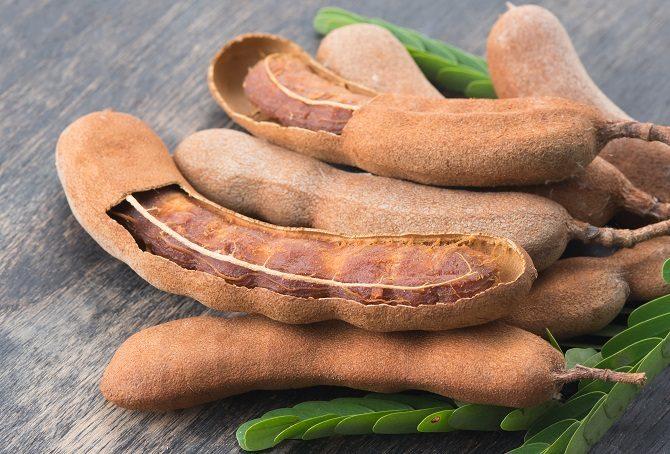Tamarind is the one fruit that does not have to be forced down a kid’s throat! Deliciously tangy, it is a firm favourite with most people and a comfort food that adults find themselves indulging in ever so often.From eating it straight from the pods, to sucking on the seeds to enjoying it as a pickle or a candy, there are numerous ways to enjoy this leguminous fruit.In fact, tamarind is used in a variety of Indian dishes as well to lend them a tart flavour. And the best part is that tamarind is not just amazingly tasty, it is very good for your health too.
What Is Tamarind?

Tamarind | Image source: https://www.chowhound.com/food-news/200245/how-to-cook-with-tamarind/
Tamarind (Tamarindus indica) is a leguminous tree in the family Fabaceae indigenous to tropical Africa. The genus Tamarindus is a monotypic taxon (having only a single species).
The tamarind is a long-lived, medium-growth tree, which attains a maximum crown height of 12 to 18 metres (39 to 59 ft). The crown has an irregular, vase-shaped outline of dense foliage. The tree grows well in full sun. It prefers clay, loam, sandy, and acidic soil types, with a high resistance to drought and aerosol salt (wind-borne salt as found in coastal areas).
The tamarind tree produces pod-like fruit that contains an edible pulp used in cuisines around the world.Because of tamarind’s many uses, it is cultivated around the world in tropical and subtropical zones.
As a tropical species, it is frost-sensitive.The fruit has a fleshy, juicy, acidulous pulp. It is mature when the flesh is coloured brown or reddish brown.
The seeds are somewhat flattened, and a glossy brown. The fruit is best described as sweet and sour in taste, and is high in tartaric acid, sugar, B vitamins, and, unusually for a fruit, calcium.
The fruit is harvested by pulling the pod from its stalk.As the fruit matures it becomes sweeter and less sour (acidic) and the ripened fruit is considered more palatable.
Benefits Of Tamarind
Different parts of tamarind (T. indica) are recognized for their various medicinal properties. A previous study reported that the seed, leaf, leaf veins, fruit pulp and skin extracts of tamarind possessed high phenolic content and antioxidant activities.
- Heart health: Tamarind is great for your heart because it lowers blood cholesterol and blood pressure. In fact, it has also been shown to have a positive effect in reducing harmful LDL cholesterol. The potassium content in tamarind helps lower blood pressure, while the Vitamin C in it neutralises harmful free radicals.
- Digestion: Tamarind has always been used in Ayurvedic medicines to cure digestion issues. Tamarind stimulates bile production that leads to quicker and efficient digestion. It is also rich in fibre, which adds bulk to stools and helps easy bowel movements. It is hence used as a natural laxative and interestingly works for some cases of diarrhoea as well since it has natural binding agents like gums and pectins.
- Rich in nutrients: Tamarind is rich in a number of essential nutrients. For instance, if you eat 100 grams of tamarind a day, you will get 36% of thiamin, 35% of iron, 23% of magnesium and 16% of phosphorus recommended for you daily. It also has plenty of niacin, calcium, vitamin C, copper, and pyridoxine. It also has many antioxidants essential for good health.
- Weight loss aid: Tamarind contains a compound called Hydroxycitric Acid that prevents an enzyme in your body from storing fat. This acid also reduces appetite by upping serotonin neurotransmitter levels. So effective is tamarind in weight loss that there are many studies being conducted on it.
- Good for nerve function: Tamarind contains the B vitamin Thiamine that is essential for the proper functioning of nerves and development of muscles. Make sure you include some tamarind in your diet every day to get its benefits.
- Reduces inflammation: Tamarind is effective in reducing inflammation as it has high levels of tartaric acid, a strong antioxidant, that makes short work of free radicals. Geraniol, another natural antioxidant in it has been shown to suppress pancreatic tumor growth. High levels of polyphenols and flavonoids have been shown to have a beneficial effect on a host of conditions including diabetes. In fact studies have shown that tamarind has an anti-diabetic effect.
Nutritional Value of Tamarind
100 grams of tamarind pulp contains following nutrients
- Calcium 35 mg
- Magnesium 92 mg
- Phosphorus 54 mg
- Protein 10 g
- Potassium 375 mg
- Riboflavin 07 mg
- Thiamin 16 mg
- Tartaric acid 8-23.8 mg
Somethings to try with Tamarind
Tamarind Drink

Tamarind Drink | Image Source: https://thepioneerwoman.com/food-and-friends/tamarind-101/
Ingredients
- 1 lb fresh Tamarind shelled
- 4 cups of water
- 1 cup of brown sugar
Instructions
- Add all ingredients to a saucepot , and bring to a rapid boil.
- Reduce heat to a simmer and boil for 30 minutes
- Let this cool and strain through a sieve, using a spoon to assist in getting all the pulp through the sieve.
- Use a funnel to transfer into a tall bottle and refrigerate for 1 hour before serving.
- Garnish with a sprig of mint.
Tamarind Balls

Ingredients
- ½ cup Tamarind Paste
- ½ garlic clove, finely crushed
- ½ Thai chili pepper, crushed finely
- 1 cups white or brown sugar plus additional for rolling
- Pinch of salt
Instructions
Place tamarind, garlic, chili pepper and salt in a bowl. Using your hands, mix all the ingredients together. Roll into even sized balls and then roll in sugar.
Notes
- If you are using fresh tamarind you will have to remove the shell and seeds.
- If the tamarind mixture is not holding together when rolled, add ½ tsp of water to the mixture.
- Use wet hand will prevent any sticking when forming the tamarind into balls. It will also help the sugar to stick to the outside.
- Tamarind paste can be found at most Asian Markets.
Article References:
- https://www.naturalfoodseries.com/13-benefits-tamarind-juice/
- https://en.m.wikipedia.org/wiki/Tamarind
- https://www.organicfacts.net/health-benefits/herbs-and-spices/tamarind.html







1 Comment